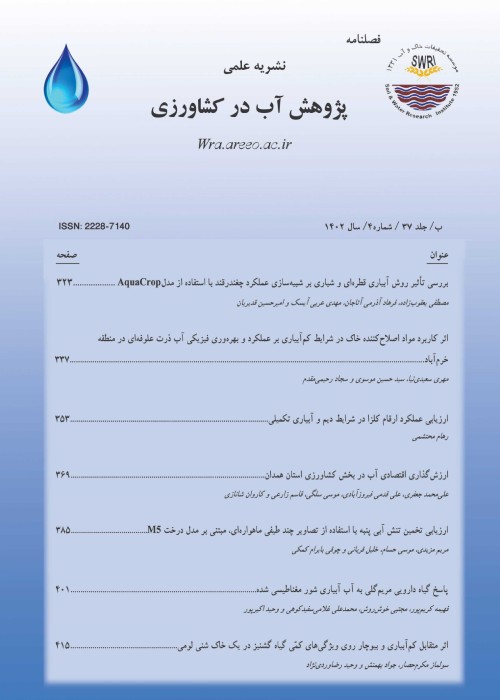Yield and Water Productivity of Wheat in Cotton-Wheat Rotation under Different Tillage and Crop Residue Managements
Author(s):
Article Type:
Research/Original Article (دارای رتبه معتبر)
Abstract:
Effects of different irrigation levels on yield, water consumption, water use efficiency, and agronomic characteristics of cotton-wheat crop rotation were examined in the temperate zone of Khorasan Razavi. The study was conducted in Gonabad Research Station, using split-split plots based on randomized complete block design with three replications, in 2015-2016. Three tillage methods (no-till, conventional tillage, and reduced tillage) were in the main plots, three residue managements (without residue, 30% of the residues and 60% residue) in sub plots, and three levels of irrigation water (50%, 75% and 100 percent of the water required according to the National Water Document) were in sub-sub plots. Parsi wheat cultivar was used for cultivation. The results showed that the highest (non-significant) grain yield of wheat was obtained from no-tillage and without residue treatment. It was determined that no tillage and direct cultivation resulted in increased wheat grain yield and could be recommended economically, since it would reduce production costs. However, keeping or removing plant residues did not have a significant effect on yield, although the positive effects of plant residues on the improvement of soil properties and, consequently, on the yield of crops in the medium to long term are evident. The highest wheat yield (6249 kg/ha) was obtained from no-tillage with 30% residue and 100% of the water requirement. The highest water use efficiency of wheat (1.57 kg/m3) was obtained in no-tillage, without residue and 50% of the water requirement. The highest yield of wheat was recorded in the full irrigation (100%) treatment and was significantly different from other irrigation treatments (75%). By applying 50% of the water requirement, wheat yield decreased by 36.3% and by applying 75% of the water requirement wheat yield dropped by 31.5%. As a result, it is possible to save water consumed by wheat under a conservation agriculture system because water productivity increased in comparison with the conventional agricultural system.
Keywords:
Language:
Persian
Published:
Journal of Water Research in Agriculture, Volume:33 Issue: 1, 2019
Pages:
81 to 93
magiran.com/p1984981
دانلود و مطالعه متن این مقاله با یکی از روشهای زیر امکان پذیر است:
اشتراک شخصی
با عضویت و پرداخت آنلاین حق اشتراک یکساله به مبلغ 1,390,000ريال میتوانید 70 عنوان مطلب دانلود کنید!
اشتراک سازمانی
به کتابخانه دانشگاه یا محل کار خود پیشنهاد کنید تا اشتراک سازمانی این پایگاه را برای دسترسی نامحدود همه کاربران به متن مطالب تهیه نمایند!
توجه!
- حق عضویت دریافتی صرف حمایت از نشریات عضو و نگهداری، تکمیل و توسعه مگیران میشود.
- پرداخت حق اشتراک و دانلود مقالات اجازه بازنشر آن در سایر رسانههای چاپی و دیجیتال را به کاربر نمیدهد.
دسترسی سراسری کاربران دانشگاه پیام نور!
اعضای هیئت علمی و دانشجویان دانشگاه پیام نور در سراسر کشور، در صورت ثبت نام با ایمیل دانشگاهی، تا پایان فروردین ماه 1403 به مقالات سایت دسترسی خواهند داشت!
In order to view content subscription is required
Personal subscription
Subscribe magiran.com for 70 € euros via PayPal and download 70 articles during a year.
Organization subscription
Please contact us to subscribe your university or library for unlimited access!




